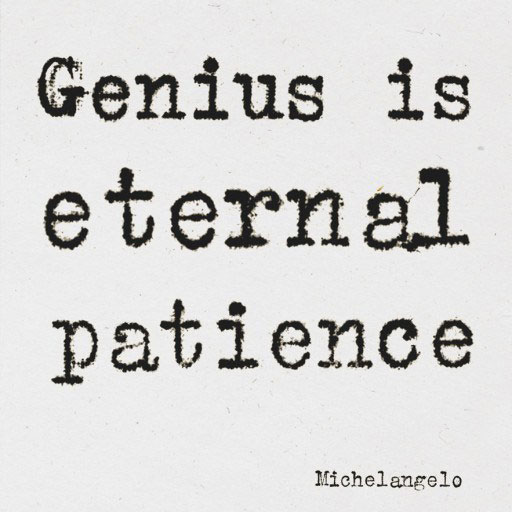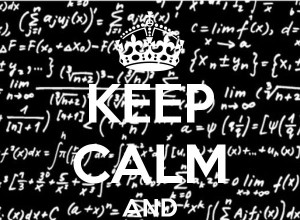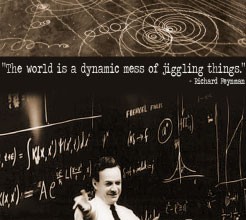NOTHING IS NOTHING … BUT SURELY STRANGE INDEED!
Mathematical physics represents the purest image that the view of nature may generate for humanity; this image presents all the character of the product of art; it begets unity, it is true and has the quality of sublimity; this image is to physical nature what music is to the thousand noises of which the air is full ~ Théophile de Donder as quoted by Ilya Prigogine in his Autobiography given at the occasion of Prigogine’s 1977 Nobel Prize in Chemistry.
I will just broad-stroke the topics involved here and try to inter-connect them and draw a deep isomorphism at the end. Let me set the stage. One of the deepest aspects of the AdS/CFT duality is the notion that local symmetries may not be fundamental: the duality basically says that if we deform the CFT by source fields by adding:
![]()
this will be the dual to an AdS theory with a bulk field ![]() with boundary condition:
with boundary condition:
![]()
with ![]() the conformal dimension of the local operator
the conformal dimension of the local operator ![]() and
and ![]() the number of covariant indices of
the number of covariant indices of ![]() minus the number of contravariant indices. Hence, we get a dual source field for every gauge-invariant local operator and can deduce the duality as:
minus the number of contravariant indices. Hence, we get a dual source field for every gauge-invariant local operator and can deduce the duality as:
![Rendered by QuickLaTeX.com \[{\left\langle {T\left\{ {\exp \left( {\int {{d^d}x\,{J_{4D}}(x)\vartheta (x)} } \right)} \right\}} \right\rangle _{CFT}} = {\not Z_{AdS}}\left[ {\underbrace {\lim }_{boundary}J\,{w^{\Delta - d + k}} = {J_{4D}}} \right]\]](https://www.georgeshiber.com/wp-content/ql-cache/quicklatex.com-cdc5fdbdaac4c4ed2505d0082672de8e_l3.png)
or more informatively:
![]()
where ![]() is the ‘bulk-field‘,
is the ‘bulk-field‘, ![]() the radial coordinate that is dual to the renormalization group in the boundary theory, with:
the radial coordinate that is dual to the renormalization group in the boundary theory, with:
![]()
and ![]() in the CFT boundary of AdS with
in the CFT boundary of AdS with ![]() coupled to
coupled to ![]()
The left-hand-sides are the vacuum expectation value of the time-ordered exponential of the operators over CFT; the right-hand-sides are the quantum gravity generating functional with the given conformal boundary condition. So, on one side, we have a gauge theory in flat space-time at weak coupling and as the coupling increases, the theory must be described as a string-theory in curved space-time. Moreover, at really strong coupling, gravity can only be interpreted as a Sasaki-Einstein holographic emergent property. Lately and increasingly, in the AdS/CFT setting, the relation of the original theory without gravity and the one with gravity is best, and it looks only, describable in the context of non-commutative (NC) quantum field theory. There are many important reasons to have non-commutativity. Here are three central ones. One, a quantum theory of gravity in the NC setting needs no renormalizability. Second, at the Planck scale, the graviton can be Picard-Lefschetz ‘localized’ even in light of the energy-time Heisenberg uncertainty relation. And thirdly, NC quantum field theories are now necessary in string-theory: one can actually prove that the dynamics of a D-brane in the presence of anti-symmetric fields can only be described in terms of a Moyal-product deformed gauge theory: hence non-commutativity! Given all that, the Seiberg-Witten map is crucial, since it takes one from a commutative gauge field to a non-commutative one, and the effect of such a map gives rise to the NC-parameter ![]() on matter background fields and induces the interactions that are metaplectically quasimorphic to gravity, where
on matter background fields and induces the interactions that are metaplectically quasimorphic to gravity, where ![]() is the Poisson tensor and the Moyal product
is the Poisson tensor and the Moyal product ![]() :
:
![]()
with:
![]()
holding. The Seiberg-Witten map expansion however has notorious ambiguities that threaten any theory of quantum gravity. To see the ![]() ambiguity in the gauge field, the Seiberg-Witten map
ambiguity in the gauge field, the Seiberg-Witten map ![]() to first order
to first order ![]() is:
is:
![]()
with:
![]()
Note, the ambiguities are parametrized by a ‘real’ constant ![]() and can be gotten rid of via a gauge transformation of
and can be gotten rid of via a gauge transformation of ![]() with parameter:
with parameter:
![]()
So, for scalars, we have:
![]()
Now, a field redefinition transforms the action, however it should not affect the physics … but since gravity is universally ‘sensitive’ to all orders of actional-modification, the Seiberg-Witten map will cause a physical deformation in the gravitational field that is inconsistent with Heisenberg’s UP for energy-time. Let me address this issue in this post via a holographic emergent interpretation of gravity. Given that NC scalar fields ![]() in the
in the ![]() adjoint representation in Minkowski space-time is:
adjoint representation in Minkowski space-time is:
![]()
with:
![]()
Let the Seiberg-Witten map act on ![]() and
and ![]() . One gets with
. One gets with ![]() in first-order terms:
in first-order terms:
![]()
with ![]() being the SuSy-Picard-D’Alembert operator.
being the SuSy-Picard-D’Alembert operator.
Now, the action for a scalar density field ![]() with Poincaré weight
with Poincaré weight ![]() in a gravitationally non-minimally ‘scalar curvature coupled’ background is:
in a gravitationally non-minimally ‘scalar curvature coupled’ background is:
![]()
with ![]() the vacuum polarization strong coupling constant and:
the vacuum polarization strong coupling constant and:
![]()
is the covariant scalar density derivative of weight ![]() . Taking the limit
. Taking the limit ![]() , one gets:
, one gets:
![]()
Hence, the following hold:
![Rendered by QuickLaTeX.com \[\left[ {\begin{array}{*{20}{c}}{{h^{\mu \nu }} = {\theta ^{\mu \alpha }}F_\alpha ^\nu + {\theta ^{\nu \alpha }}F_\alpha ^\mu + \frac{1}{2}{\eta ^{\mu \nu }}\theta F}\\{h = \, - \frac{\mu }{{1 + 6\mu }}\overline \theta F}\\{\mu = \, - \frac{1}{{6 + \frac{{1 + 4{w_p}}}{{2\alpha }}}}}\end{array}} \right.\]](https://www.georgeshiber.com/wp-content/ql-cache/quicklatex.com-31983ad0d2d0f371df9f52867fee4a96_l3.png)
for arbitrary ![]() .
.
To deal with the Seiberg-Witten ambiguities in the field setting, we consider a potential for the NC-field ![]() that is polynomial:
that is polynomial:
![]()
with:
![Rendered by QuickLaTeX.com \[\widetilde V\left( {\overline \phi } \right) = \sum\limits_{n\, > 1} {\frac{1}{n}} \frac{{{V^{(n)}}}}{{{\phi ^n}}}\]](https://www.georgeshiber.com/wp-content/ql-cache/quicklatex.com-6b3716cd6eb5510e284d2547bb4676b4_l3.png)
The action of the Seiberg-Witten map allows us to thus derive:
![]()
and on the gravity side, we get:
![]()
and after linearization, one obtains:
![]()
After solving, we have:
![]()
Thus:
![]()
So we have succeeded in restricting the ambiguities to the density weight and the key here is only one monomial can be allowed in ![]() . Therefore, the holographic emergent gravity context can only allow one type of self-interaction; so we get on the AdS side:
. Therefore, the holographic emergent gravity context can only allow one type of self-interaction; so we get on the AdS side:
![]()
and on the CFT side, the vacuum polarization strong coupling constant is hence eliminable. That is key, since the gravitational background can be derived as:
![]()
with:
![]()
Hence, the linearized Ricci scalar for that background is:
![]()
and from that it follows that both, the background and the Ricci scalar depend on Seiberg-Witten ambiguities if ![]() but in the non-commutative field theory, any physical process has to be independent of
but in the non-commutative field theory, any physical process has to be independent of ![]() . To deal with this, note that upon quantization of the particle dispersion relation of the plane-waves gives us the particle velocities corresponding to the scalar field. Let us derive them in the gravitational background to deduce the dispersion. On the gauge side, we have:
. To deal with this, note that upon quantization of the particle dispersion relation of the plane-waves gives us the particle velocities corresponding to the scalar field. Let us derive them in the gravitational background to deduce the dispersion. On the gauge side, we have:
![]()
On the gravity side, one can derive the dispersion relation via:
![]()
Hence:
![]()
with ![]() . One is now in a position to derive:
. One is now in a position to derive:
![]()
and by solving, one can totally eliminate the Seiberg-Witten ambiguities, as there are no dispersion on the AdS boundary. Now the hard part. One must analyze the Seiberg-Witten map to higher-order and in non-linear form approximation on the ‘AdS/CFT’ gravity-side. For that, one needs higher order ![]() terms in the Seiberg-Witten map. To deduce exactness in the AdS setting, one varies the coordinate parametrization on the boundary with a gauge field coupling; hence, the NC action is:
terms in the Seiberg-Witten map. To deduce exactness in the AdS setting, one varies the coordinate parametrization on the boundary with a gauge field coupling; hence, the NC action is:
![]()
with a matrix identity:
![]()
If we expand in ![]() , we get:
, we get:
![]()
to lowest order with ![]() and hence no ambiguities. Comparing:
and hence no ambiguities. Comparing:
![]()
with:
![]()
we can get:
![]()
with
![]()
So, the lesson in higher order of the Seiberg-Witten map is that the action:
![]()
allows us, given non-commutative quantum field theory, to deduce that gravity, after Seiberg-Witten disambiguation, is AdS/CFT holographic-emergent, and this implies the existence of supersymmetric non-commutative theories that remove UV and IR divergences: what a bonus, that plague ‘classical’ non-commutative field theories. Summing for this post, besides disambiguiation: the Seiberg-Witten map entails the deep result that the SuSy algebra is isomorphic to the Clifford algebra corresponding to the Sasaki-Einstein space associated with SuGra. Extra bonus: we have eliminated the Seiberg-Witten map ambiguities in the AdS/CFT context in a way that allows us to deduce an isomorphism permitting ‘quantum causality‘ for a holographic emergent gravity living on the ‘AdS/CFT’-boundary.
NOWHERE TRUER THAT IN MATHEMATICS
Young man, in mathematics you don’t understand things. You just get used to them. ~ John von Neumann. Reply, as reported by Dr. Felix T. Smith of Stanford Research Institute to a physicist friend who had said “I’m afraid I don’t understand the method of characteristics.” — as quoted in footnote of pg 226, in The Dancing Wu Li Masters: An Overview of the New Physics (1991) by Gary Zukav.




